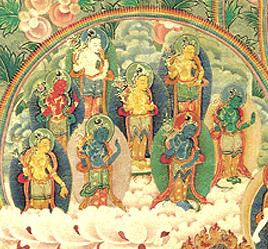Six paramitas: Difference between revisions
Jump to navigation
Jump to search
(Removed Sanskrit Tibetan as it's defined in the individual Wiki entries.) |
|||
| Line 17: | Line 17: | ||
===Shastras=== | ===Shastras=== | ||
The six paramitas are mentioned and explained in many of the most important Indian sources, such as | The six paramitas are mentioned and explained in many of the most important Indian [[Mahayana]] sources, such as | ||
*[[Nagarjuna]]’s ''[[Letter to a Friend]]'', | *[[Nagarjuna]]’s ''[[Letter to a Friend]]'', | ||
*[[Chandrakirti]]’s ''[[Introduction to the Middle Way]]'' and | *[[Chandrakirti]]’s ''[[Introduction to the Middle Way]]'' and | ||
Revision as of 12:23, 20 March 2020

The six paramitas or 'transcendent perfections' (Skt. ṣaṭpāramitā; Tib. ཕ་རོལ་ཏུ་ཕྱིན་པ་དྲུག་, parol tu chinpa druk; Wyl. pha rol tu phyin pa drug) comprise the training of a bodhisattva, which is bodhichitta in action.
- Generosity: to cultivate the attitude of generosity.
- Discipline: refraining from harm.
- Patience: the ability not to be perturbed by anything.
- Diligence: to find joy in what is virtuous, positive or wholesome.
- Meditative concentration: not to be distracted.
- Wisdom: the perfect discrimination of phenomena, all knowable things.
The first five paramitas correspond to the accumulation of merit, and the sixth to the accumulation of wisdom. The sixth paramita can be divided into four, resulting in ten paramitas.
Written Sources
Sutras
| This section contains Tibetan script. Without proper Tibetan rendering support configured, you may see other symbols instead of Tibetan script. |
Shastras
The six paramitas are mentioned and explained in many of the most important Indian Mahayana sources, such as
- Nagarjuna’s Letter to a Friend,
- Chandrakirti’s Introduction to the Middle Way and
- Shantideva’s Bodhicharyavatara.
Teachings Given to the Rigpa Sangha
- Sogyal Rinpoche, Dzogchen Beara, Ireland, 8 July 2012
- Dzogchen Rinpoche, London, 19-23 June 1998
Further Reading
- Dzogchen Ponlop, Rebel Buddha (Boston: Shambhala, 2010), pages 124-132.
- Geshe Sonam Rinchen, The Six Perfections, translated by Ruth Sonam (Ithaca: Snow Lion, 1998), ISBN 978-1559390897
- Khenpo Ngawang Pelzang, A Guide to the Words of My Perfect Teacher (Boston & London: Shambhala, 2004), pages 181-219.
- Patrul Rinpoche, The Words of My Perfect Teacher (Boston: Shambhala, Revised edition, 1998), pages 234-261.
- Khenpo Kunpal, The Nectar of Manjushri's Speech, translated by Padmakara Translation Group. Published by Shambhala. ISBN 978-1-59030-439-6
- Khenpo Palden Sherab Rinpoche,Ceasless Echoes of the Great Silence, a Commentary on the Heart Sutra. Translated by Khenpo Tsewang Dongyal Rinpoche. Pages 81-96. Published by Sky Dancer Press. ISBN 1-880976-01-7
References
- ↑ See The Fortunate Aeon: How the Thousand Buddhas Became Enlightened (Berkeley: Dharma Publishing, 1986), Vol. One, pages 97-477.
